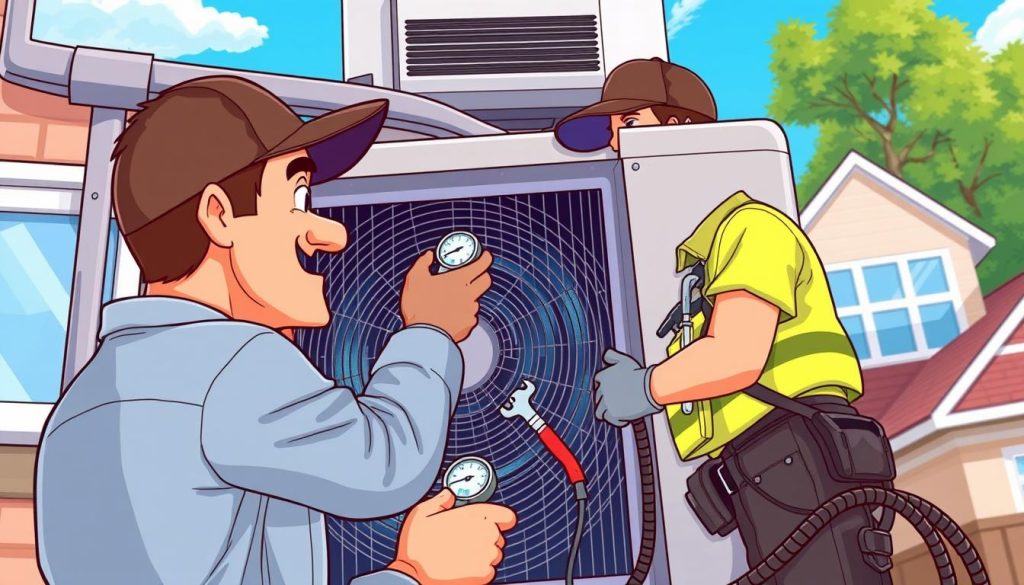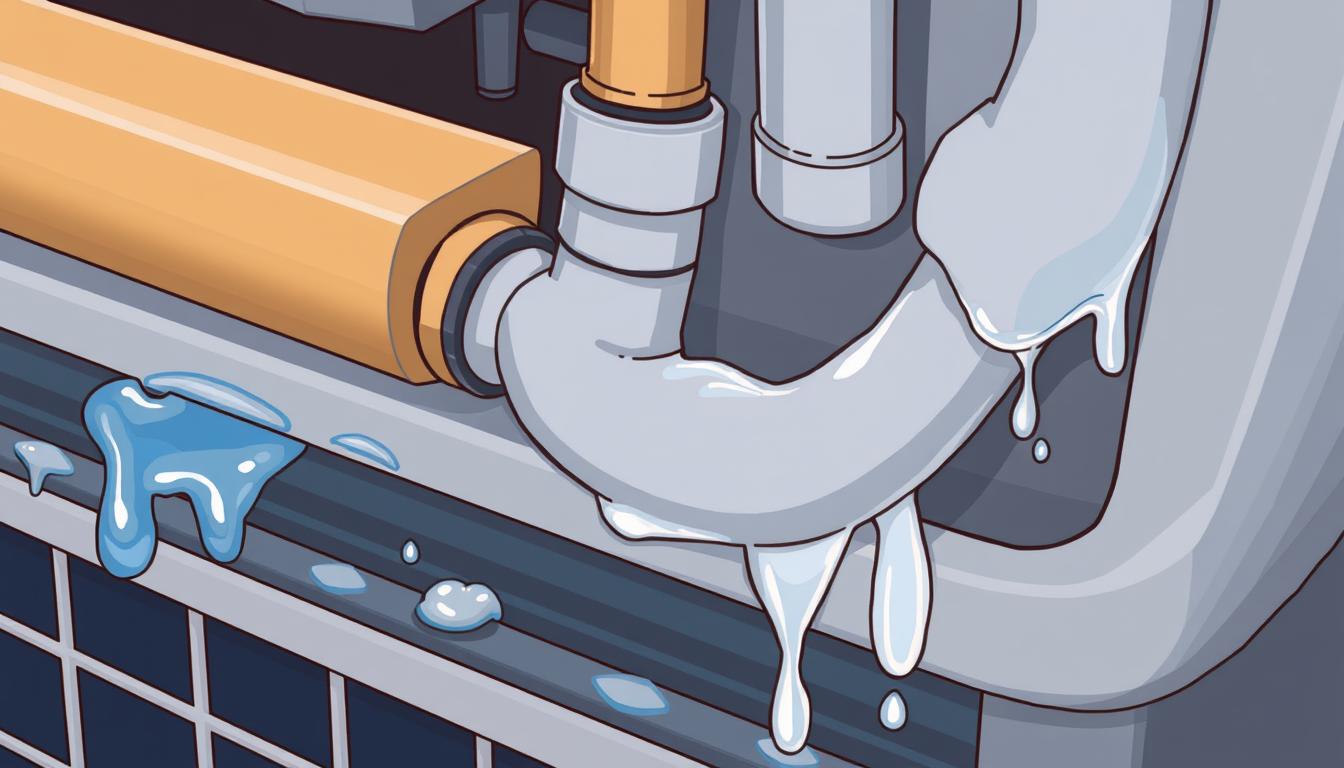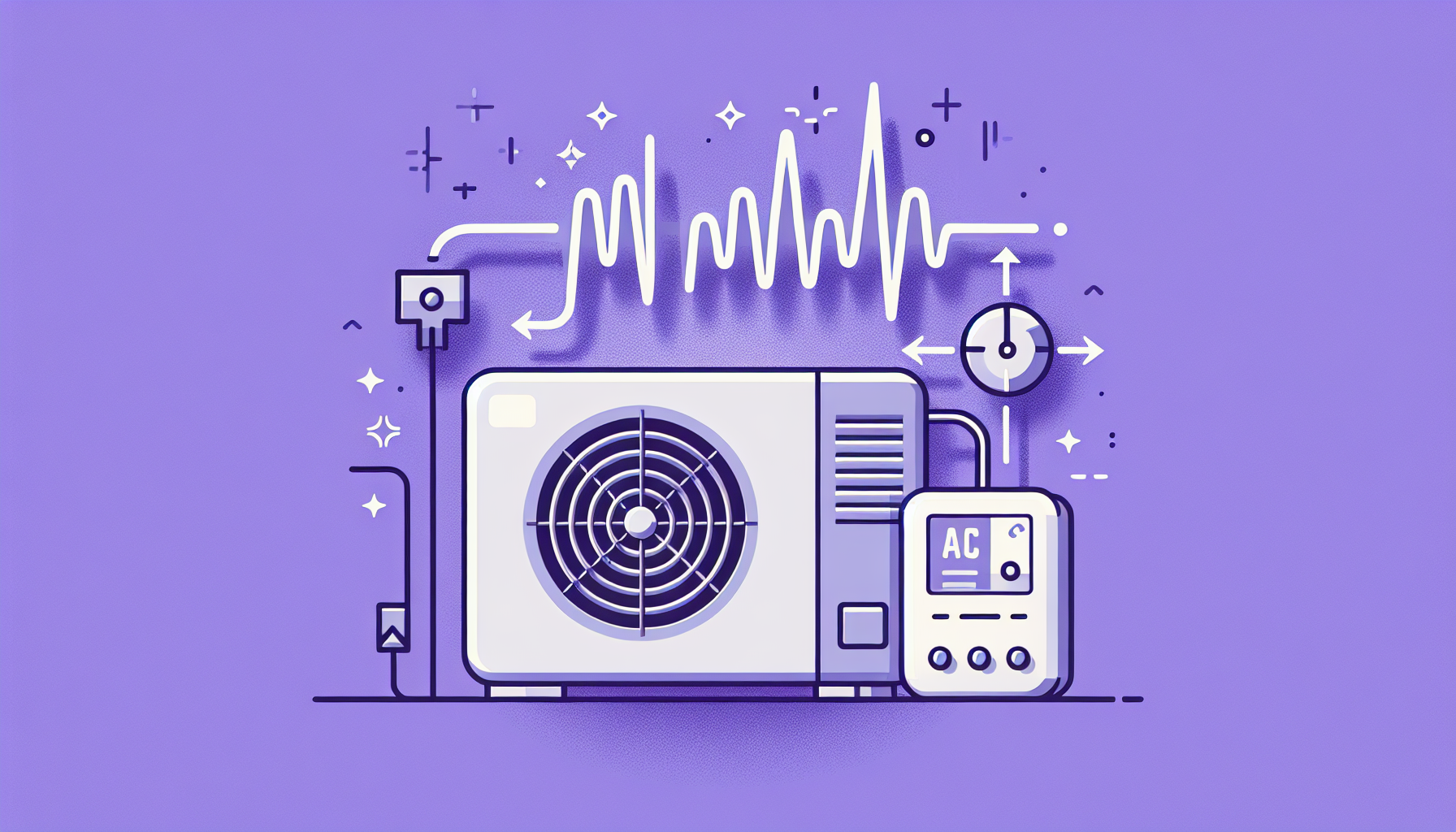If your air conditioning system isn’t working right, it might have a refrigerant leak. Finding out if you have an AC leak is key to keeping your HVAC system running well. Knowing the signs and how to check for leaks can help fix the problem fast. This way, you avoid bigger issues and save on energy costs.
Key Takeaways
- Poor cooling performance, longer cooling cycles, and higher utility bills are signs of an AC refrigerant leak.
- Identifying the leak location by looking for a sweet odor or oil spots can help pinpoint the source of the problem.
- Diagnostic methods like the bubble test, refrigerant leak detector, and UV dye test can be used to detect and locate AC leaks.
- Proper maintenance and addressing refrigerant leaks promptly can help extend the life of your HVAC system.
- Understanding the legal aspects of freon usage and the ongoing phase-out of R-22 refrigerant is important for AC repair and maintenance.
Signs of an AC Refrigerant Leak
If your air conditioning system shows any of these problems, it might have a refrigerant leak. Refrigerant is crucial for your AC’s health. A leak can hurt its performance and efficiency.
Poor Cooling Performance
Without enough refrigerant, your AC can’t cool your home well. You might feel warmer or it takes longer to cool down, even when the AC is on.
Longer Cooling Cycles
With less refrigerant, your AC works harder and longer. This means longer cooling times and higher energy use.
Humid Indoor Air
An air conditioner should make your air less humid. If your air feels too damp, it might mean your AC is leaking refrigerant.
Ice on Evaporator Coils
Refrigerant leaks can make the evaporator coils too cold. This causes ice to form, making it harder for your AC to cool your home.
Higher Utility Bills
With a refrigerant leak, your AC uses more energy. This leads to higher bills. It’s a sign that your AC needs attention.
If you see these signs, get your AC checked by a pro. They can find and fix the leak quickly. This helps prevent more damage and keeps your AC running smoothly.
Identifying the Leak Location
Spotting an air conditioning (AC) refrigerant leak can be tricky. But, there are clear signs to help you find it. A sweet smell, like nail polish remover, is a big giveaway. This smell can guide you to start looking for the where to find ac refrigerant leak.
You might also see oil spots on refrigerant lines or joints. These oil stains mean the oil leaks from ac system. They help you pinpoint the leak’s exact spot.
Sweet Odor Similar to Nail Polish Remover
A sweet smell, like nail polish remover, is a clear sign of a leak. This smell comes from the refrigerant gas escaping. It’s a clue to where the leak starts.
Oil Spots on Tubes or Components
Oil spots on refrigerant lines or joints are another sign. The oil in the coolant is meant to lubricate. But if it leaks, it leaves stains. Finding these spots helps you track down the leak.
Knowing these signs helps you find and fix an AC refrigerant leak. It’s the first step to getting your cooling system working again.
Bubble Test for Detecting Leaks
If you think your AC system has a refrigerant leak, the bubble test can help. It’s a simple DIY method. You spray soapy water on the refrigerant lines and connections to see leaks.
To do the bubble test for ac leaks, you need a few things:
- Spray bottle or applicator
- Mild dish soap
- Water
Here’s how to do the soapy water leak detection step-by-step:
- Mix 1 liter of water with 0.5 teaspoon of dish soap for the soapy solution.
- Spray the soapy water on the refrigerant line joints and connections all over the finding leaks in ac system.
- Look closely at the sprayed areas. Big bubbles mean you have a refrigerant leak.
The bubble test works well for big leaks. But, it might miss small ones. For a detailed check, use a refrigerant leak detector or other tools to find the source of the leak.
Fixing AC refrigerant leaks fast is key to keeping your cooling system working well. The bubble test helps you find the leak fast. Then, you can fix it right away.
How to diagnose an AC leak?
For complex air conditioning (AC) refrigerant leaks, a refrigerant leak detector is very helpful. These tools have sensors that find Freon or other refrigerants. They are great for spotting leaks that are hard to see.
Use a Refrigerant Leak Detector
To find leaks with a refrigerant leak detector, the technician just turns it on. Then, they slowly move the nozzle or probe along the refrigerant lines. The detector shows where the leaks are, helping to fix them right away.
Using a refrigerant leak detector has many advantages:
- Highly accurate leak detection – The sensors can find even tiny leaks.
- Ease of use – It’s easy to use, making finding leaks quick.
- Versatility – It works with many refrigerant types, like Freon and R-410A.
With electronic sensors for AC leaks, technicians can solve tough refrigerant problems. This keeps your air conditioning system running well.
Pressure Resistance Test
Dealing with hard-to-find AC refrigerant leaks? A pressure resistance test is your best bet. It uses compressed nitrogen or another gas to pressurize the AC system. Technicians watch the pressure gauges for any changes.
These changes show a leak. The escaping gas’s hiss helps find where the leak is.
This test is great for finding tiny holes or punctures in the AC system. By watching the pressure, technicians can quickly find and fix the leak. It’s a key tool for AC repair pros to ensure accurate diagnoses.
How Does the Pressure Resistance Test Work?
- The technician connects a nitrogen or inert gas supply to the AC system.
- The system is pressurized to 150-300 psi.
- Technicians watch the pressure gauges for any drops, which mean a leak.
- They listen for the escaping gas’s hiss to find the leak’s location.
Key Benefits of the Pressure Resistance Test
- Precise Leak Detection: Finds even tiny leaks, ensuring a complete diagnosis.
- Efficient Troubleshooting: Helps technicians quickly find and fix the leak.
- Improved System Performance: Fixing the leak makes the AC system work better, saving energy and cooling well.
| Pressure Test for AC Leaks | Using Nitrogen to Find AC Leaks | Troubleshooting AC System Pressure |
|---|---|---|
| The pressure resistance test is an effective way to diagnose and locate even the most elusive AC refrigerant leaks. | Nitrogen is a commonly used inert gas for pressurizing AC systems during the pressure resistance test. | Monitoring pressure fluctuations is a crucial step in the pressure resistance test to identify the source of the leak. |
UV Dye Test for AC Leak Detection
The UV dye test is a top choice for finding air conditioning (AC) refrigerant leaks. It works by adding a special UV dye to the AC system during a recharge. Then, a black light is used to find the dye, showing where the leak is.
This method is favored over others because it’s easy to use. It helps spot leaks in the compressor, fittings, and other key areas. This makes it a go-to for finding refrigerant leaks.
How Does the UV Dye Test Work?
The UV dye test for AC leaks is simple:
- The AC system is first emptied and then filled with the right refrigerant.
- A bit of UV dye is added to the system, usually through a service port.
- The system is then filled with pressure, and a black light is used to scan it.
- Where the UV dye shows up means you’ve found the leak.
The UV dye is made to work well with refrigerant. It spreads through the system, showing even tiny leaks. This makes the UV dye test for AC leaks a great way to find and fix leaks.
Advantages of the UV Dye Test
- It’s easy to spot leaks with a black light.
- It’s great for tracing refrigerant leaks with dye and finding the leak’s source.
- It’s more accurate than the bubble test for finding small leaks.
- Works on both old and new AC systems.
- It’s affordable and doesn’t hurt the system.
Using the UV dye test for AC leaks helps find and fix refrigerant leaks fast. This keeps your AC running well and saves energy.

Legal Aspects of Freon Usage
As an air conditioning owner, knowing the legal rules about Freon, or R-22, is key. Freon was once the top choice in the U.S. but is now being phased out due to its harm to the environment.
Freon Phase-Out and R-410A Refrigerant
Freon harms the ozone layer and contributes to global warming. The U.S. Environmental Protection Agency (EPA) has set rules to limit its use. Since 2009, new AC units use safer refrigerants like R-410A, or Puron.
The EPA banned Freon in 2020. But, older AC units can still use it. The supply is getting smaller, and only EPA-licensed techs can get the remaining Freon.
With Freon’s use and supply going down, it’s time for homeowners to think about switching to r-410a refrigerant replacement. This move is good for the environment and follows the r-22 refrigerant phase out rules.
| Refrigerant | Environmental Impact | Availability |
|---|---|---|
| Freon (R-22) | High ozone depletion and global warming potential | Phased out, limited supply for existing units |
| R-410A (Puron) | Low ozone depletion and global warming potential | Widely available for new air conditioning units |
It’s important for air conditioning owners to know the laws about refrigerants. This knowledge helps them stay in line with the law, protect the environment, and keep their cooling systems working well. By understanding the move from Freon to r-410a refrigerant replacement, homeowners can make smart choices about their AC units and keep up with changing rules.
Professional AC Maintenance
Keeping your air conditioning (AC) system in top shape is crucial for preventing costly refrigerant leaks. One of the best ways to identify and address these issues early on is by getting annual tune-ups from a professional HVAC technician.
During a professional inspection, experienced technicians can detect even small refrigerant leaks that may be difficult for homeowners to notice on their own. Regular maintenance helps catch these problems before they become larger, more expensive problems. Experts recommend having your HVAC system serviced at least once a year to prevent and quickly fix any refrigerant leaks.
Why is Annual AC Tune-Up Important?
An annual tune-up for your ac system maintenance offers several benefits:
- Identifies and addresses small refrigerant leaks before they grow into bigger issues.
- Improves energy efficiency and helps prevent unexpected breakdowns.
- Extends the lifespan of your AC unit by keeping it running smoothly.
- Ensures your system is operating at peak performance for preventing ac refrigerant leaks.
What Happens During an AC Tune-Up?
During a standard annual tune ups for ac, HVAC technicians will:
- Inspect the refrigerant level and top it off if necessary.
- Check for any refrigerant leaks and seal them if found.
- Clean the coils, replace air filters, and lubricate moving parts.
- Test electrical components and thermostat to ensure proper function.
- Provide recommendations for any necessary repairs or upgrades.
By investing in regular professional ac system maintenance, you can help prevent costly refrigerant leaks and keep your cooling system running efficiently all season long.

Conclusion
This guide has given you the tools to find and fix an air conditioning (AC) refrigerant leak. You now know the signs of a leak, like poor cooling and humid air. You also know how to spot ice on coils and higher bills.
Finding where the leak is comes next. This guide showed you how to look for signs like a sweet smell and oil spots. Tools like the bubble test and UV dye test can also help find the leak.
It’s also key to know about Freon laws and the switch to R-410A. This keeps your AC running well and legally. Remember, regular HVAC checks are vital. They stop leaks and make your AC last longer.





0 Comments